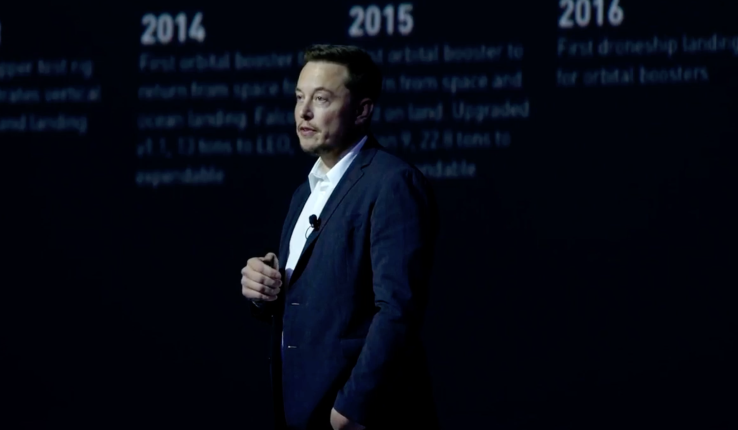

Elon Musk has a plan to colonize Mars, but he’s not rushing it. In a conference call following the SpaceX CEO’s presentation today at the International Astronautical Conference, Musk noted that the project is still essentially a hobby at the company, drawing only a fraction of its efforts.
In response to a question about whether the company should be worrying about colonizing the solar system when its rockets are still exploding on the ground, Musk was conciliatory.
“Less than 5 percent of SpaceX resources are working on planetary transport stuff,” he said. “So it is very much a secondary or tertiary priority to understanding exactly what happened on the last mission.”
“The pace of progress on Mars depends upon the pace of progress of SpaceX,” he explained. “Our success rate with Falcon 9 is roughly 93 percent — it needs to be a lot better. We need to get Falcon Heavy launched finally, Dragon 2, and make sure we manage the company such that we’ve got sufficient cash flow and funds while it’s developing — and of course, I will supplement that personally.”

Inside the SpaceX Crew Dragon
In the near term, the Dragon project must go forward both as an integral part of SpaceX’s current business and as a precursor to future missions.
“We want to use Dragon 2 as a pathfinder. We need to sort out interplanetary navigation, deep space communication at high bandwidth… then entering Mars’ atmosphere and, you know, landing,” he said. “What is landing like tremendously heavy? Dragon will be about ten times heavier than anything that has landed on Mars before.”
NASA’s Curiosity would be the next-heaviest, and they weren’t concerned about bruising colonists, or taking off again afterwards. The hovering technique worked well for a science buggy, but “you can’t do that with a giant spaceship,” Musk told the audience. It’s also unclear how the dust and debris will fly or provide sufficient resistance to rockets. He was pretty candid about the craft’s chances, in fact.
“I wouldn’t give the first Dragon landing on Mars high odds — I mean, maybe 50 percent. The history of landing on Mars is not a good one,” he admitted. “So for a first timer, I’d say if we get 50 percent likelihood, I’d say that’s pretty good.”
 Those are the robotic missions, of course, with 2 slated to launch in 2020 and more whenever it’s practical to do so. For manned missions (which tend to require more than a 50 percent projected success rate), the goal is 2024, but that plan is definitely not etched in stone.
Those are the robotic missions, of course, with 2 slated to launch in 2020 and more whenever it’s practical to do so. For manned missions (which tend to require more than a 50 percent projected success rate), the goal is 2024, but that plan is definitely not etched in stone.
“I mean, that’s optimistic,” he said. “I would describe that as an aspiration, and within the realm of possibility — a lot of things need to go right.”

